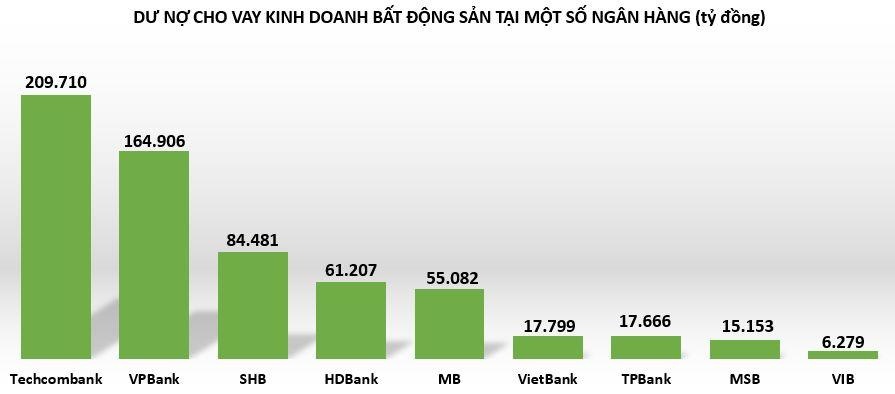Nhiều ngân hàng đang ưu ái cho vay kinh doanh

![]()
Số liệu từ Ngân hàng Nhà nước cho thấy, cuối quý III/2024, dư nợ tín dụng bất động sản đạt 3,15 triệu tỷ đồng, tăng 9,15% so với đầu năm. Trong đó, phần dư nợ tín dụng bất động sản với mục đích tự sử dụng đạt 1,88 triệu tỷ đồng, tăng 4,62%, cho thấy nhu cầu vay mua nhà của người dân đang tăng trở lại. Dư nợ tín dụng đối với hoạt động kinh doanh bất động sản đạt 1.274.233 tỷ đồng (tăng 29,18% so với cùng kỳ năm trước).
 Ảnh minh họa Ảnh minh họa |
Dù bất động sản là lĩnh vực bị đánh giá rủi ro cao, song nhiều ngân hàng vẫn định hướng cho vay nếu nhu cầu thực, dự án tốt. Vì vậy, đa số các ngân hàng thương mại đang “ưu ái” cho vay kinh doanh bất động sản. Các khoản vay này thường chiểm tỷ lệ cao nhất nhì trên tổng dư nợ cho vay khách hàng và có tốc độ tăng trưởng nhanh so với đầu năm.
Báo cáo tài chính quý III/2024 được các ngân hàng công bố mới đây cho thấy, tín dụng bất động sản có xu hướng tăng nhanh và chiếm tỷ trọng khá lớn tại một số ngân hàng.
Ngân hàng nào đang rót vốn vào kinh doanh bất động sản nhiều nhất?
Theo báo cáo tài chính hợp nhất quý III/2024, tính đến 30/9/2024, Techcombank là ngân hàng đứng đầu với 209.710 tỷ đồng dư nợ cho các doanh nghiệp vay kinh doanh bất động sản, tăng gần 19% so với đầu năm, chiếm 34,9% trên tổng dư nợ cho vay của khách hàng.
Đặc biệt tại ngân hàng MB, dư nợ vay kinh doanh bất động sản ghi nhận hơn 55.082 tỷ đồng, tăng 27% so với đầu năm, tuy nhiên chỉ chiếm gần 8% tổng dư nợ vay của ngân hàng.
Dư nợ vay kinh doanh bất động sản tại TPBank cũng tăng 21% so với đầu năm, ghi nhận 17.666 tỷ đồng, chiếm 7,54% tổng dư nợ cho vay của khách hàng.
Ngoài ra, ngân hàng MSB, VietBank cũng đang rót hàng chục nghìn tỷ đồng vào kinh doanh bất động sản. Cụ thể, dư nợ cho vay kinh doanh bất động sản tại MSB hơn 15.153 tỷ đồng, tăng 15%, chiếm 8,88% tổng dư nợ vay; Trong khi đó, tại VietBank cũng tăng 11%, ghi nhận hơn 17.799 tỷ đồng, nhưng chiếm tỷ trọng lên tới 19,4% tổng dư nợ cho vay khách hàng.
Đáng chú ý, ngân hàng VIB có tốc độ tăng trưởng dư nợ cho vay kinh doanh bất động sản lên tới 275% so với đầu năm, tương ứng tăng từ 1.673 tỷ đồng lên gần 6.279 tỷ đồng. Tuy nhiên, tỷ trọng cho vay bất động sản mới chỉ chiếm 2,1% tổng dư nợ cho vay khách hàng của ngân hàng này.
Ở nhóm ngân hàng quốc doanh (BIDV, Vietcombank, Vietinbank), dư nợ cho vay kinh doanh bất động sản tính đến thời điểm 30/9/2024 không được thuyết minh trên báo cáo tài chính.
 |
Thực tế, cho vay kinh doanh bất động sản được công bố trong báo cáo tài chính của các ngân hàng chủ yếu là các khoản cho các doanh nghiệp kinh doanh bất động sản vay để phát triển dự án. Phần lớn các khoản cho cá nhân, hộ gia đình vay mua nhà không được hạch toán vào nhóm này – mà được ghi nhận ở khoản cho vay cá nhân (cho vay tiêu dùng bất động sản). Vì vậy, dư nợ cho vay bất động sản tại một số ngân hàng có thể lớn hơn.
Huy Tùng – Lê Thanh
Theo kinhtexaydung.petrotimes.vn Copy







